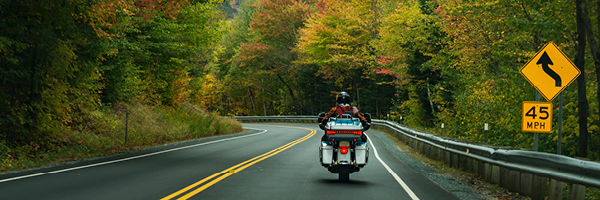
“Look twice, save a life” isn’t just a slogan—it’s solid advice. While safety should always be the main concern whenever you’re driving, when automobiles and motorcycles begin to share the road in warmer months, it’s a good idea to be extra vigilant.
Remember, motorcycles are vehicles with the same rights and privileges as any vehicle on the roadway. It’s important for motorists to understand the safety challenges faced by motorcyclists, such as size, visibility and motorcycle riding practices, to know how to best respond to them.
Whether you’re the one operating the automobile or the motorcycle, check out our 10 tips on motorcycle safety for car drivers to make sure everyone makes it to their destination safely.
1. Share the road, not the lane.
Although it may look like there’s enough room in a single lane for both an automobile and a motorcycle, remember the motorcycle needs the room to maneuver safely. Give the motorcyclist some space and don’t share the lane. Car drivers should be aware that a motorcyclist may weave between traffic and momentarily share the lane. If this happens, slow down and allow plenty of space to share the road while the motorcyclist maneuvers.
2. Increase your following distance for flashing turn signals.
Self-cancelling turn signals didn’t become standard on motorcycles until the 1970s, and there are still a lot of motorcycles on the road today without them. When you see a flashing turn signal on a motorcycle, wait to be sure the motorcycle is going to turn before you attempt to pass it. If you notice that a motorcyclist has been driving with the turn signal on for a while, increase your following distance so that if it does turn, you’ll have enough time to react.
3. A minor annoyance to a motorist could be a major hazard to a motorcyclist.
Motorcyclists may change speed or adjust their position within a lane suddenly in reaction to road and traffic conditions, such as potholes, gravel, wet or slippery surfaces, pavement seams, railroad crossings and grooved pavement. As a car driver, one way to look out for motorcycles in these conditions is to provide extra space for bikers to react.
4. Remember that motorcycles react differently.
Did you know that in dry conditions motorcycles can stop more quickly than cars? Allow more following distance so you have enough time to react in case the motorcycle makes a sudden stop since rear-ending a motorcycle can be fatal to the rider.
5. Look in all directions during left turns.
Motorcycle crashes involving another motor vehicle continue to account for nearly half of all motorcyclist fatalities in the United States. Before you turn left, remember to look for oncoming traffic, especially motorcycles. Vehicle accidents involving the collision of a left-turning automobile and an oncoming motorcycle can be severe, as oftentimes the motorcycle T-bones the automobile while it’s in the left turn. Driving with extra caution while making left turns is just one way to increase motorcycle safety.

Learn about our
Auto Insurance
6. Treat intersections with special care.
Many accidents that involve both automobiles and motorcycles occur at intersections. Always follow the safety protocol for intersections every single time that you approach one: come to a complete halt, view and obey posted traffic signs and signals, look both ways for approaching traffic and proceed slowly to avoid motorcycle accidents.
7. Check your blind spots.
Motorcycles are small and may be difficult to see. With a smaller profile, it can also be difficult to judge the speed and distance of an oncoming motorcycle, particularly in blind spots. Plus, the shape and size of a motorcycle can blend into the images in your rear and side-view mirrors. Newer technology, including lane departure warning and blind spot detection systems, have helped with this issue but nothing beats the old fashioned over-the-shoulder glance. If you’re driving on an interstate or highway with higher speed limits, take your time and consider checking your mirrors and windows several times for motorcycle riders before you change lanes.
8. Pass with care.
When a motorist passes a motorcyclist, the gust of wind that follows could cause the motorcycle to become unstable. Always use your turn signal before changing lanes or merging to allow the motorcyclist to anticipate traffic flow and find a safe lane position. When passing, make sure you are several car lengths ahead of the motorcycle before you return to your lane.
9. Keep weather in mind.
Inclement weather has more drastic effects on motorcyclists than it does on motorists, particularly rain, snow and wind. Windy conditions can make it difficult for motorcyclists to control their motorcycle on the road, and precipitation like rain or snow can reduce everyone’s visibility and make motorcycles more difficult to see. Give motorcycle riders extra space in wet or windy weather conditions.
10. Help riders stay safe at night.
You can help motorcyclists stay safe after dark by increasing your following distance, ensuring that your high-beams are turned off when you notice an approaching motorcycle and refraining from passing.
For more motorcycle safety tips for car drivers, talk to your Grange independent agent today and learn about motorcycle insurance.
Coverages described herein may not be available in all states. Please contact one of our local independent agents for complete details on coverages and discounts. If the policy coverage descriptions herein conflict with the language in the policy, the language in the policy applies. The material provided above is for informational, educational and/or suggestion purposes only, and does not imply coverage. WE RESERVE THE RIGHT TO REFUSE TO QUOTE ANY INDIVIDUAL PREMIUM RATE FOR THE INSURANCE HEREIN ADVERTISED. Applicable policies may be underwritten by Grange Insurance Company, Trustgard Insurance Company, Grange Indemnity Insurance Company, Grange Insurance Company of Michigan* and Grange Property & Casualty Insurance Company*, Integrity Insurance Company*, Integrity Property & Casualty Insurance Company*, Integrity Select Insurance Company*. *Not licensed in Pennsylvania
References:
National Highway Traffic Safety Administration (NHTSA)
United States Department of Transportation
Insurance Institute for Highway Safety (IIHS)